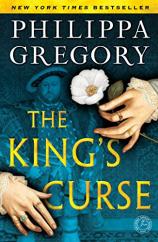Reading Group Guide
Discussion Questions
The King's Curse

1. THE KING’S CURSE spans over 40 years of Lady Margaret Pole’s presence in and around the Tudor court, as she and her family rise and fall from favor with Henry VII and then Henry VIII. How do Lady Margaret, her characteristics and her goals change over the course of her life at and away from court?
2. Discuss the meaning of the title, THE KING’S CURSE. What is the actual curse? How does Henry VIII’s belief that he is cursed affect his behavior? Do you believe that the curse that Elizabeth of York and her mother spoke against the Tudors comes to fruition?
3. Consider how deeply Margaret is affected by the execution of her brother Edward, “Teddy,” the Earl of Warwick. How does this affect her familial loyalty and influence her actions? What does it mean to Margaret to bear the name Plantagenet? What does the White Rose mean to her?
4. How does Margaret see Henry VIII change over the course of his life? As a child, how was he different from his brother Arthur, Prince of Wales? What are his primary characteristics as a young king, and then as an aging monarch?
5. Describe the ways in which motherhood and maternity are portrayed in THE KING’S CURSE. How does the pressure to produce a male heir define the role of royal mothers? How does Margaret’s presence at the loss of so many royal babies affect her own view of motherhood? Compare the differences between Katherine of Aragon’s and Margaret’s sense of motherhood.
6. Lady Margaret Pole is a unique figure in the Tudor court: when her title is restored to her, she becomes one of the wealthiest individuals in England in her own right. In what ways does Margaret use her position and influence that was unusual for a woman of this time?
7. “‘It’s just that from boyhood, the king has never admired something without wanting it for himself,’” Margaret cautions her cousin Edward, Duke of Buckingham. How does Margaret’s advice to her family to desire obscurity, and therefore safety, contradict her ambitions for her family, her sons in particular, and desire for power? What does the loss of Margaret’s son Arthur mean to her? Consider this moment: “We walk back to the house, and I look at the great house that I have renewed, with my family crest above the door, and I think, as bitterly as any sinner, that all the wealth and all the power that I won back for myself and my children could not save my beloved son Arthur from the Tudor sickness.”
8. Margaret forces Reginald to stay in the king’s service as a scholar and theologian, even if it means being exiled to Padua, Paris and Rome and separated from his family; Reginald resents his mother for much of his life because of this. Do you think this shaped Reginald’s opinion toward the new religion and his eventual letter to the king on his findings? Why or why not?
9. Compare and contrast Margaret’s attitudes about illness, contagion, and death with those of Henry VIII. How does each handle the Sweat and other diseases among their subjects? How is each affected by the death of Katherine of Aragon?
10. Think back to the promise that Margaret made to Katherine when she first revealed Prince Arthur’s deathbed wish to his young wife: If Margaret had not promised to keep Katherine’s secret then, how might have the following events turned out differently?
11. The wheel of fortune, or rota fortunae, is a popular notion in medieval philosophy that refers to the unpredictability of fate: the goddess Fortuna spins the wheel at random, changing the positions of those on the wheel. Keeping this in mind, discuss the many great fortunes and misfortunes that befall Margaret and her family, and England as a whole, throughout the novel. What is the driving force behind these quick changes of fortune?
12. “The one thing I would have taught him, if I had kept him at my side, is to never weary of life, but to cling to it. Life: at almost any cost. I have never prepared myself for death, not even going into childbed, and I would never put my head down on the block.” Margaret encourages her children to choose life on multiple occasions, even over loyalty or truth. What does this tell us about Margaret’s moral compass? How does this guide the decisions she makes for herself and her children?
13. Lady Margaret Pole was beatified by the Catholic Church as a martyr in 1886 by Pope Leo XIII; her feast day is celebrated on May 28th. In THE KING’S CURSE, Margaret is portrayed as devout to the church and the old ways and is outraged when Henry VIII allows Cromwell to shut down England’s abbeys, priories and monasteries. How does Margaret’s religious devotion influence her family’s involvement with the Pilgrimage of Grace? How do you think Margaret reconciles her disagreement with the king over religious issues, but outward loyalty to the throne?
Enhance Your Book Club
1. THE KING’S CURSE provides a different perspective on some of the same events that are included in many Tudor novels, including books by Philippa Gregory, such as THE OTHER BOLEYN GIRL. Compare Margaret Pole’s version of events with those in works of historical fiction set in this era. If you haven’t read any, check out the other books in Philippa Gregory’s Cousins’ War series and Tudor Court novels.
2. Read a nonfiction account of the life of the real Lady Margaret Pole, Countess of Salisbury, born Margaret of York, such as MARGARET POLE, COUNTESS OF SALISBURY, 1473–1541: Loyalty, Lineage and Leadership by Hazel Pierce, and don’t miss the extensive bibliography at the end of THE KING’S CURSE for further reading.
3. Visit Philippa Gregory’s website to learn more about the author, the Plantagenet family tree and history.
4. Follow Philippa Gregory on Facebook or Twitter for regular updates about Philippa’s research and historical characters.
The King's Curse
- Publication Date: April 7, 2015
- Genres: Fiction, Historical Fiction
- Paperback: 640 pages
- Publisher: Touchstone
- ISBN-10: 1451626126
- ISBN-13: 9781451626124








